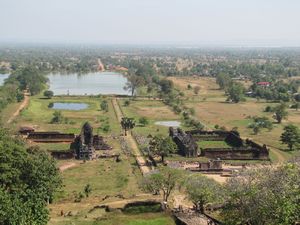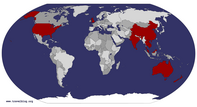Advertisement
Published: December 15th 2010

 Great views
Great views
wonder why the Kings left this for Cambodia?We soon found ourselves back in Pakxe which we were going to use as a base for a couple of excursions to the surrounding sites. We felt that Pakxe itself had very few star attractions to recommend it for more than a day (two at most), but it was in a great location for a visit to Wat Phou and the Bolaven Plateau, and more importantly for our onward flight to Louang Prabang aboard Lao Airlines (yikes). Also one of the evenings we had planned to treat ourselves to a night in a real life palace – the Champasak Palace, but more about that later.
For our two days seeing the surrounding area we had decided not to pay out for tours, which would ultimately limit us to someone else’s itinerary, but brave it and hire a motorbike. This duly accomplished and helmets chosen (although, as none were small enough for Lisa we did have to question the efficacy of the one she had which jiggled around on her head whenever she moved!) we braved the Laos traffic and headed out to our first day’s destination; Wat Phou. Having been absolutely blown away by the magnificence of the temples at

 Older than Angkor
Older than Angkor
being lovingly restoredAngkor Wat in Cambodia, we were quite hesitant about what we would find and whether what is described as “the most evocative Khmer ruins outside Cambodia’s borders” would actually live up to its hype. Wat Phou, which means Mountain Monastery in Lao, has been designated a World Heritage site by UNESCO and dates back to the 5th century, so a pre-runner to Angkor Wat. It stands at the foot of a rather magnificent 1500 metre tall mountain, Lingaparvata, overlooking the lush valley. Apparently the chosen site was auspicious to Hindu worshippers and more particularly Shiva - all to do with the phallic symbol apparently!
In order to get to Wat Phou there were a number of hurdles to overcome first. After about an hour’s bike ride towards Champasak the first hurdle loomed ahead of us – the mighty Mekong. So a short ride on a ferry was in order to get to Champasak and then just a little further south we would be at Wat Phou. When we mention ferry, the mind conjures up pictures of large-ish boats where vehicles drive into its belly. Well you wouldn’t expect that in Laos would you – no. Our ferry consisted of

 Easy Rider
Easy Rider
nope, just easythree boat hulls tied together with planks of wood strapped on top. A rickety ramp was slightly lowered to enable the mini-buses to embark but not after additional planks were added so they didn’t get stuck in the soft sand. Getting our bike on board was significantly easier, especially after I had got off to enable Chris to have better balance (to date I am still shit scared of motorbikes). After the ferry was full with mini-buses and us we started across the muddy Mekong to Champasak. Luckily it was only a few minutes but still quite exciting, as with most things in Asia, just making it alive sometimes seems a miracle in itself. Back on dry land we headed off to Wat Phou and our second lot of hurdles; the most pot-holed roads probably in existence. After a number of bone crunching, neck breaking collisions with some potholes large enough to hide a whole Laos village in we eventually arrived at Wat Phou.
My God what an absolutely stunning and breathtaking setting, dare we say better than Angkor. The temples were not only located at the base of the mountain, but appeared to be in perfect harmony with

 The Entrance
The Entrance
Were grand oncethe mountain as the temples progressed up its base – priceless prime real estate. Walking along the stone causeway, flanked by low stone pillars in the shapes of lotus buds, we made our way towards to two of the better preserved buildings. According to local legend these were segregated palaces (one for women the other for men – how progressive) but archaeologists are sceptical and there are lots of these working on the buildings so we should assume that they know best. The buildings were in quite a bad state of repair, with walls being propped up as the restoration progresses, but nevertheless it was still possible to see what remains of some beautiful decorative lintels. What was obvious though was its similarity to Angkor in its symmetry and in its heyday it must have been an awe inspiring spectacle to walk up that hallowed causeway towards a beautiful complex that represented the power of the Khmer nation. The Khmer kings left here and travelled further south to what is now Cambodia and centred the kingdom at Angkor but they kept a major temple for hundreds of years after.
Further into the site we had to climb up a

 Reclaimed
Reclaimed
Nature has been taking the mountain backsandstone stairway, lined with lovely frangipani trees, towards another set of ruins. As the climb was steep we were certainly grateful for the small amount of shade the trees offered and we marvelled at how some of the trees pushed their way through, and clung onto, the stairway. The uppermost temple was in an even worse state of repair, but this really didn’t detract from how lovely it was. In fact it was in a way perfect; that nature had over time reclaimed what was originally hers at the expense of this most revered of places. It was beautiful and serene, especially when the tour groups had gone and we could sit on a stone for a while and just marvel at the view in solitude and what an absolutely breathtaking view it was over the lush valley.
At the site there was also the “crocodile stone” which apparently was used for human sacrifices – although this again is heavily disputed – and a stone with an elephant carving on it, however this could be considered graffiti as it only dates back to the 19th century. One of the most interesting things was behind the temple and was simply

 Spooky
Spooky
Nope just smokya shallow cave from which the sacred water from the mountain seeped. We watched as locals took the water and washed their heads with it, but as it is not considered good form for foreigners to partake of this ritual we decided we wouldn’t offend anyone, although the thought of some welcoming cold water in the heat was very tempting. In times gone by this water was used in the various ceremonies held in the temple, most notably the coronations of the Khmer kings, and was channelled down from the cave into the temple by a series of stone pipes – plumbing ahead of its time.
Although we were initially concerned about whether the temple complex would live up to Angkor we were not disappointed. True it was not as big, true it was not in such good repair (which will hopefully be resolved as the restoration progresses), but its location was beautiful and the lush mountainous scenery helped to evoke the haunting image. Now just for the bike ride back to Pakxe; renegotiating the potholes and the ferry!
Our second day of excursions was to the Bolaven Plateau with the aim of seeing two things it is

 Just Roasted
Just Roasted
and delicious to eat or drinkknown for; coffee and waterfalls. Although coffee growing dominates the plateau today, the French saw its potential for growing strawberries, tea and cardamom, as well as coffee, and the main export at the time was in fact cardamom. Before the French saw the potential of the area it was farmed by the local hill tribes, and today there are 12 different ethnic groups that still inhabit the area. Indeed the plateau’s name comes from one of these local groups, the Laven. The plateau itself is actually a huge extinct volcano and the ‘Plateau’ is the crater and with an average altitude of 600m the weather is somewhat cooler than low-lying Pakxe.
Our first stop was a small coffee plantation, WonCoffee, part owned by a Dutch chap whose love of the bean was all too apparent as he made us lovely cups of coffee which he roasted and ground himself. He gave us a tour of the coffee plants near his house explaining the different types of bean and how they are harvested. We then had a tour of the area behind his house where he was nurturing the coffee plants of the future. All in all it was a

 Waterfalls
Waterfalls
Always lovely after the rainsvery interesting few hours spent in good company with someone who has a love of coffee. After following the whole process, he showed us how to hand roast, which actually has more of an effect on the taste then even the type of bean. Great smell & great tasting beans as well, freshly roasted.
After 5 or 6 cups of very strong coffee we climbed back aboard our trusty steed and headed off to visit some waterfalls (although being so full of caffeine we could probably have run it faster). This meant more spine jangling unmade roads but with some lovely views at the end of it. The three falls we chose to visit were Tad Yuang, Tat Fane and Tat Cham Pee. They were very pretty in different ways; Tat Fane was quite spectacular at about 100m tall and Tat Cham Pee was a pretty semi-circular waterfall where we could swim. Although by the time we arrived here it was quite late so decided that we would not bother with a dip in the cold water. One thing, as we visited these three sites, which took us by surprise was the fee we had to pay to get

 Still smiling
Still smiling
well you would be in this lovely settinginto see each of the waterfalls, which we felt was quite steep. We didn’t mind paying for the car parks but were unable to fathom what our entrance money actually paid for – probably not the upkeep of the local area unfortunately. With a bit of western bravado we managed to only pay a reduced rate at one and got away without paying at another but the waterfalls were very pretty and we were glad that we spent a day on the Bolaven. A few more days would have been nice to get a further look at what the area had to offer and have a better look at the scenery, but our palace awaited us.
For our last night in Pakxe we had decided to splash out and pay for a room at the Champasak Palace. After all we had gone to tea at Buckingham Palace so a night in the Champasak Palace seemed like a natural progression!!!!! The palace was built for Prince Boun Oum na Champasak, the last king in southern Laos, who (so the story goes) needed a place this big to house all his concubines!! I wonder which concubine was supposed to have our

 Our Palace home
Our Palace home
for one night at leastroom? It was started in 1969 but was still unfinished when the king fled to France in 1975 and then bought up by a Thai company who turned it into a hotel. I wonder what happened to the concubines? Anyway, our room was spacious albeit a bit tired, but it was a nice way to spend the last night in Pakxe before we braved Lao Airlines to Louang Prabang.
Advertisement
Tot: 0.07s; Tpl: 0.013s; cc: 12; qc: 28; dbt: 0.0406s; 1; m:domysql w:travelblog (10.17.0.13); sld: 1;
; mem: 1.1mb














